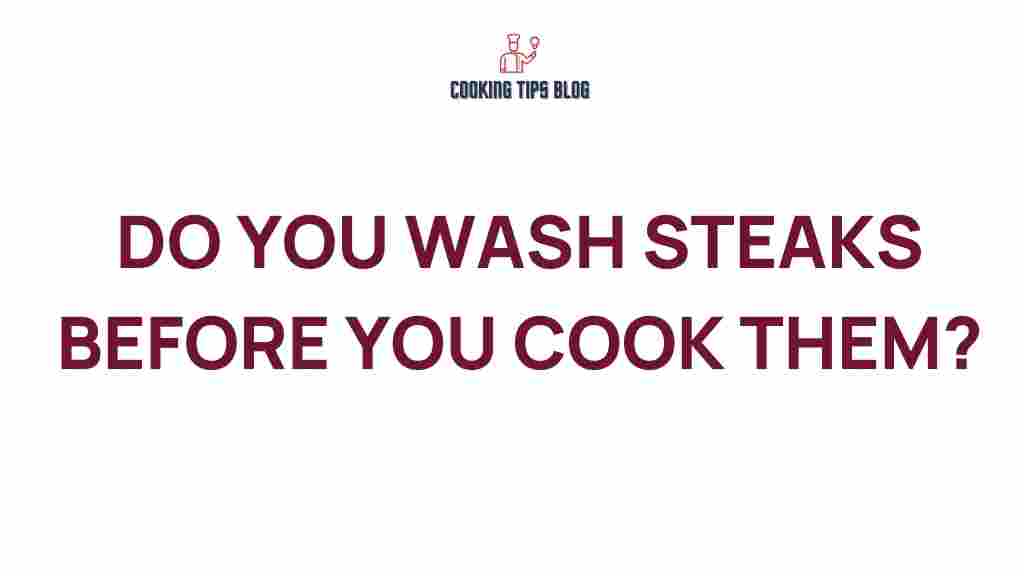The Great Steak Debate: Should You Wash Your Meat Before Cooking?
When it comes to cooking steak, there are countless debates among culinary enthusiasts, but one question stands out: should you wash your meat before cooking? The practice of washing steaks has garnered attention for years, with opinions divided among chefs, home cooks, and food safety experts. In this article, we’ll explore the pros and cons of washing steaks, the science behind meat preparation, and best practices for ensuring a delicious and safe dining experience.
Understanding Washing Steaks
The first step in our exploration is to understand what washing steaks entails. Washing refers to rinsing the meat under cold water to remove any surface contaminants or bacteria. Advocates of this practice believe that washing can enhance the cleanliness of the meat, while opponents argue that it can do more harm than good. So, let’s dive into the core reasons people consider washing steaks.
The Arguments For Washing Steaks
- Removing Surface Contaminants: Proponents argue that washing can help eliminate any surface bacteria or contaminants that may be present on the meat.
- Improved Flavor: Some cooks believe that rinsing the steak can remove excess blood or residues, leading to improved flavor.
The Arguments Against Washing Steaks
- Cross-Contamination Risk: Washing steaks can splatter water droplets containing bacteria onto surrounding surfaces, increasing the risk of cross-contamination in your kitchen.
- Cooking Kills Bacteria: Cooking steak to the appropriate internal temperature is sufficient to kill harmful bacteria, making washing unnecessary.
- Texture and Taste: Washing can alter the texture of the meat and may lead to a less desirable outcome when cooked.
The Science Behind Washing Steaks
To better understand the implications of washing steaks, it’s essential to consider the science involved. Meat, including steak, can harbor bacteria on its surface. However, these bacteria are typically eliminated during cooking. When you wash steak, the water can spread these bacteria around your kitchen, which poses a significant health risk.
The USDA and food safety experts recommend against washing meat and poultry. According to the USDA, washing meat can spread bacteria around your kitchen, which can lead to foodborne illnesses. Instead, they advise that the best way to ensure meat is safe to eat is by cooking it to the correct temperature.
Best Practices for Meat Preparation
Instead of washing your steak, consider these best practices for preparation:
- Store Properly: Keep steak in the refrigerator at a temperature below 40°F (4°C) to prevent bacterial growth.
- Use Clean Utensils: Always use clean cutting boards and knives when preparing meat to avoid cross-contamination.
- Thorough Cooking: Cook steak to a safe internal temperature. For medium-rare, aim for an internal temperature of 130°F (54°C) to 135°F (57°C).
Step-by-Step Process for Preparing Steak Without Washing
Here’s a simple process for preparing steak without washing:
- Gather Your Ingredients: You’ll need a good cut of steak, seasoning (salt, pepper, or your choice of spices), and any marinades or oils.
- Remove from Packaging: Carefully take the steak out of its packaging and discard any plastic or paper.
- Pat Dry: Use paper towels to pat the steak dry. This helps achieve a good sear when cooking.
- Season: Generously season the steak on both sides with salt and pepper or your preferred seasoning.
- Cook: Heat your grill or pan to high heat and cook the steak to your desired doneness.
Troubleshooting Common Issues
While preparing steak, you might encounter some common issues. Here are some troubleshooting tips:
- Steak Sticking to the Grill/Pan: Ensure your cooking surface is well-oiled and preheated. Avoid flipping the steak too soon.
- Uneven Cooking: Use a meat thermometer to monitor the internal temperature and ensure even cooking.
- Too Tough or Chewy: Avoid overcooking, and consider using a marinade to tenderize tougher cuts of meat.
Conclusion: The Final Verdict on Washing Steaks
After weighing the arguments for and against washing steaks, it is clear that the risks outweigh the benefits. Washing steaks can lead to cross-contamination, and cooking at the right temperature is the most effective way to ensure safety. It’s essential to follow proper meat handling practices and focus on cooking techniques to achieve a delicious steak without the need for washing.
In summary, while the debate will likely continue among culinary circles, the consensus among food safety experts is clear: washing steaks is unnecessary and potentially harmful. Instead, focus on proper storage, preparation, and cooking techniques to guarantee a delightful steak experience.
For more tips on safe cooking practices, check out this helpful resource. And if you want to explore more about steak preparation, visit our cooking guide for insights and recipes.
This article is in the category Tools and created by Cookingtipsblog Team
